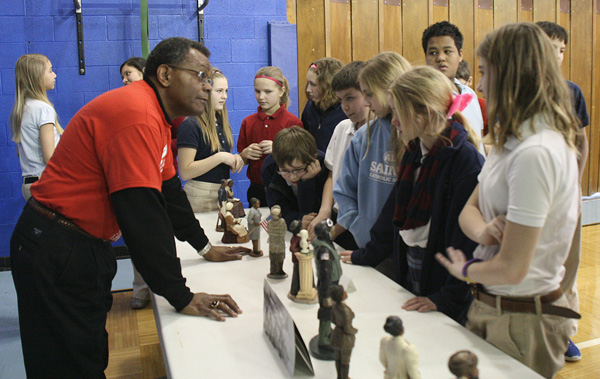
By Anne Marie Amacher
DAVENPORT – Standing before sixth-, seventh- and eighth-graders at All Saints Catholic School, Jim Collins asked the students, “What is today – Feb. 12?”
Abraham Lincoln’s birthday, many responded. Collins then asked, “What was the most significant thing that Lincoln was noted for as the 16th president?” Signing the Emancipation Proclama-tion, they responded.
That proclamation, signed Jan. 1, 1863, Collins noted, would keep the United States united as one country and eventually led to slaves being free. “A nation divided will not stand,” Collins recited from the proclamation.
Collins, a member of Sacred Heart Cathedral in Davenport, spoke to the middle school students as part of Black History Month.
He told the story of St. Martin de Porres (1579-1639), the first black saint in the Americas, who was canonized in 1962. Collins is a member of the cathedral’s St. Martin de Porres Society.
Holding a portrait of St. Martin de Porres, Collins explained that the saint was raised by a single parent who sent him off to an apprenticeship program. His mentor worked in the health field. When Martin de Porres went to the Dominican Brothers, he wanted to serve them. He did so by working with the poor and sick.
Collins then moved along several long tables full of statues of African Americans, wood carvings and other artifacts. He has collected the items since the 1970s and has nearly 100 in his collection.
He picked up a statue of Bessie Coleman, the world’s first black woman pilot. Not only did she fly planes, but maintained them too. She is buried in Chicago where each year pilots fly over her gravesite and drop flowers in recognition of what she did in the early 1900s, Collins noted.
He showed a photograph of civil rights leader Martin Luther King Jr. with Father Francis Duncan of St. Ambrose College (now university) in Davenport. Collins told of the partnership between St. Ambrose University and the city of Davenport. The university raised money for signage along Marquette Street from the Mississippi River to 67th Street that commemorates the street as Martin Luther King Drive. The city installed the signs.
Holding various statues, Collins told the students about Bishop Richard Allen who started the first black Methodist Church; Harriett Tubman, who escaped from slavery and formed the Underground Railroad to bring fellow slaves to freedom; Frederick Douglass, an escaped slave who became a famous abolitionist; Madame C.J. Walker, a self-made millionaire and philanthropist; and Andy Freeburg, the first African American to graduate from West Point Military Academy.
Collins’ favorite is Dr. George Washington Carver. “He saved the South from an agriculture disaster.” Collins said Carver graduated from Iowa State University where he studied agriculture. Booker T. Washington, principal of the African American Tuskegee Institute, hired Carver to lead the institute’s agriculture department. Carver developed numerous products from peanuts and potatoes, including peanut butter. Peanuts put nutrients into soil that had been depleted of nutrients by cotton, a crop heavily planted in the South.
After sharing stories about many other African-Americans, Collins took questions. Students continued to ask about the identities of other African Americans whose statues were displayed on the table. He talked about a few more history makers, but encouraged the students to come forward and look at the names, then go learn about one or two people.
“Education is where it starts,” Collins said.
“I think Dr. Carver helped save the United States because he developed something to put in the soil and that helped the cotton grow. I didn’t know he did that as I thought he just invented different ways to use peanuts,” said eighth-grader Shannon McNeal.
“I learned that black people weren’t treated fairly until the 1960s and I feel that today they still aren’t treated fairly and that makes me sad. We should all be treated the same,” said sixth-grader Hailie Dreyer.
“I am interested in African history. My grandparents were from Africa. I learned that black people weren’t treated fairly, but they really did cool things,” said sixth-grader Jordan Kent.
“I learned about African American culture. I also learned what African American people did for America,” said eighth-grader Cassidy Dyne-Grand.







